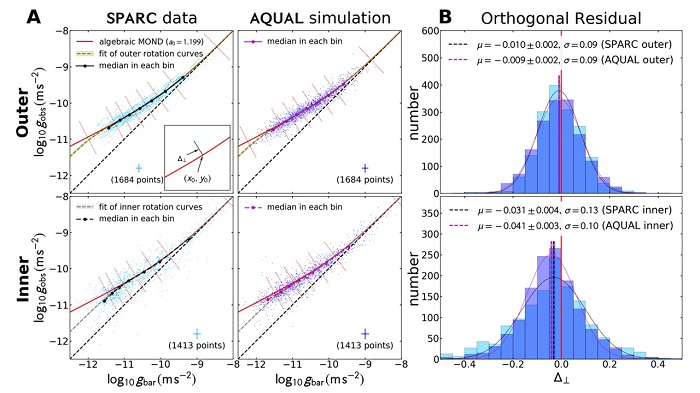Modified gravity is boosted by a deeper analysis of galactic rotation
curves: modified inertia may be out, and dark matter is questioned once again
Department of Phsics & Astronomy,
Sejong University
Prof. Kyu-Hyun Chae
One of the mysteries of the universe is that Einstein’s general relativity, which is a relativistic theory of Newton’s universal law of gravity, requires large amount of dark matter in individual galaxies and in the vast space of the universe. Dark matter inferred by general relativity has never been identified in non-gravitational experiments. This opens up the possibility that gravity’s law may be subtly different from general relativity while keeping all its experimental successes (known generally as modified gravity) or Newton’s inertia is modified. Such a paradigm known as modified Newtonian dynamics, or MOND for short, was proposed by Mordehai Milgrom in 1983.
Galactic rotation curves measured by hydrogen gas orbiting in galactic disks provide powerful testbeds in testing and distinguishing theoretical possibilities. The currently popular cosmological model with cold dark matter and Einstein’s cosmological constant Λ (widely referred to as ΛCDM) predicts the properties of dark matter halos embedding galaxies of stars and gas, so that galactic rotation curves can be predicted by Newtonian dynamics or general relativity. The drastically different MOND paradigm (either modified gravity or modified inertia) proposes to explain galactic rotation curves with only the observed mass distribution of stars and gas.
In disk galaxies where orbits of stars and gas are collectively forming disk geometries, modified gravity and modified inertia predict subtly different rotation velocities in the inner rising part of the rotation curve. This is because in modified gravity theories rotation velocities in the inner disk are slightly suppressed because of gravity perpendicular to the disk plane. Such a suppression causes the rotation curve on an acceleration plane to deviate from the MOND curve. According to kinematics, a rotation velocity V in a circular orbit of radius R means an observed centripetal acceleration g_obs=V²/R while Newton’s theory also predicts an acceleration g_bar at that radius for the observed baryonic mass distribution of stars and gas. These two accelerations define the acceleration plane (Figure 1). Because this effect is tiny, it is not feasible to distinguish between modified gravity and modified inertia with any single galaxy based on current data. However, combined signals from many galaxies may distinguish the two and further provide a distinction between MOND and ΛCDM.

Figure 1 The inner and outer rotation curves of 152 SPARC galaxies are separately placed on an acceleration plane. There is a tiny, but clear difference between the inner part and the outer part in remarkable agreement with the prediction of the AQUAL theory of modified gravity.
Kyu-Hyun Chae, an astrophysicist and professor at Sejong University (Seoul, South Korea), has just done such a test using 152 high-quality galactic rotation curves selected from the Spitzer Photometry and Accurate Rotation Curves (SPARC) database. The results recently published in the Astrophysical Journal show that rotation velocities of the inner disks do not statistically fall on the curve on the acceleration plane followed by rotation velocities of the outer disks. The significance is more than 5-sigma, the usually accepted rule for a discovery. Rather, the rotation velocities of the inner disks of SPARC galaxies fall right on the somewhat deviated curve numerically predicted by the AQUAL Lagrangian theory of modified gravity proposed by physicists Jacob Bekenstein and Mordehai Milgrom. It was not difficult for Chae to recognize the difference between the inner and outer rotation curves on the acceleration plane and a detailed statistical analysis indeed confirmed it.
Chae recalls “When Milgrom and I obtained numerical solutions of AQUAL earlier this year, I became very curious about the robust prediction of the theory on the tiny difference between the inner and outer rotation curves on the acceleration plane. So, I immediately examined the SPARC data and got excited by the fact that the tiny difference was there.” However, it took some time for Chae to do a rigorous statistical analysis and investigate any possible hidden errors. He adds, “It is clear that the SPARC data prefer modified gravity over modified inertia. Of course, this conclusion needs to be confirmed by much larger and higher-quality data in the future. However, the power of the current SPARC data is still very impressive.”
Chae further asked the question of whether dark matter halos predicted by current state-of-the-art hydrodynamics simulations of galaxy formation can be as good as AQUAL, or perhaps even better, in predicting the inner and outer rotation curves. He comments on the results of the investigation, “It is interesting that dark matter halos also predict some difference between the inner and outer rotation curves on the acceleration plane, mimicking AQUAL to some extent. However, dark matter halo results deviate from the SPARC data on the acceleration plane requiring some unnatural fine tuning. What is truly surprising is that AQUAL naturally predicts both the inner and the outer rotation curves without any fine tuning.”
What’s next in testing theories with galactic rotation curves? For a more definite test than the published results, a new database is needed. Chae is currently engaged in an international collaboration including Dr. Federico Lelli of Arcetri Astrophysical Observatory - INAF (Florence, Italy) to undertake a SPARC II project funded by National Research Foundation of Korea. Chae says “The coming years will be an exciting time in search of solutions to the dark matter problem.”
References:
1. https://iopscience.iop.org/article/10.3847/1538-4357/ac93fc “Distinguishing Dark Matter, Modified Gravity, and Modified Inertia with the Inner and Outer Parts of Galactic Rotation Curves”
2. https://iopscience.iop.org/article/10.3847/1538-4357/ac5405 “Numerical Solutions of the External Field Effect on the Radial Acceleration in Disk Galaxies”
3. https://journals.aps.org/prd/abstract/10.1103/PhysRevD.106.103025 “Testing modified gravity theories with numerical solutions of the external field effect in rotationally supported galaxies”